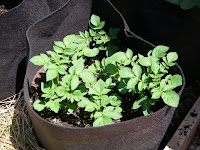"One must ask children and birds how cherries and strawberries taste."
Strawberries happen to be the first "fruit" in our area to ripen. The strawberry doesn't technically count as a fruit since in reality it is just the enlarged end of the plant's stamen. The strawberry in my opinion is the best of all the fruits. It is juicy, plump, and oh so, so very sweet. The strawberry is of course non-fat, low in calories, high in vitamin C, potassium, folic acid, fiber, and vitamin B6. The actual name for the strawberry is believed to be derived from the fact that the berries are strewn all about the plant. Hence the Old English words is streowberie or streabbelige, which litteraly means "strewn berry". This name eventually became strawberry through the shortening and metamorphosis of the word.
The strawberry is in the Rosaceae family and all the known kinds are in the genus Fragaria. The genus name Fragaria refers to the odorous nature of the fruit. It has been used as a perfume in times past. It is said that Madame Tallien, great figure during Napoleon's reign used to bathe in the juice of strawberries. She claimed that this ritual kept her skin radiant, smooth and free of blemishes. However it did take approximately 22 pounds of strawberries in order to make enough juice to fill the basin.
The ancient Greeks and Romans would harvest wild strawberries for medicinal purposes. It is believed that the Romans were the first to start to cultivate the strawberry. Native Americans harvested wild strawberries throughout the Northeast and the Midwest. It is believed that strawberry shortcake came from a meal that Native Americans would make using mashed strawberries.
In medieval Europe the strawberry was seen as a symbol of prosperity, richness, peace, and perfection as a society. It was widely used at festivals and tournaments. To this day the strawberry has an important role at Wimbledon. Each year about 60,000 pounds of strawberries are consumed at the Wimbledon tennis matches, along with approximately 2,000 gallons of cream. It is believed that this tradition of serving strawberries with cream is as old as the event itself.
In the 1900's cultivation of the strawberry began in California. California now cultivates approximately 25,000 acres of strawberries throughout the state. Making it the single largest supplier of strawberries. They produce about 80% of the world's strawberry harvest. Therefore making all of the strawberries that you buy at the grocery store are from California. This means that for many of us these strawberries must travel a far way in order to reach us. I suggest to everyone only eat strawberries in season (June for most strawberry plants) and buy them only from local farmers.
Non cultivar strawberry plants are June bearers or they produce their fruit in June. The first cultivars were cultivated to produce bigger berries. However as time went on it became the idea to try and cultivate a strawberry that would be "ever-bearing" or ones that would have two or three cycles where they bear fruit. This type of strawberry in my opinion has less taste, most probably due to the fact that in order to get the plant to do this other traits had to be lost. This is the trade off in all cultivars or hybrids. We breed a plant for a specific trait which we want but in the process we lose several other traits that are also highly important. Taste is usually one that is lost, especially in genetically modified (GM) crops.

The picture to the left is from May 26th and this same strawberry is already over half-way red. I am ready to harvest it and savor its deliciousness later this week with
Naomi. Don't forget everyone to visit your local farmers market and to buy your vegetables and fruits from there. Support your local farmers and keep your food close to home.



















 Cucumber
Cucumber Chive
Chive Scapes are the flower stems of garlic. They are removed in order to force the garlic plant to put all of its energy into creating bigger bulbs of garlic. Scapes have their own wonderful flavor and can be used in any meal as a substitute for chives or garlic. In the recipe below it was used as a substitute for garlic since we were down to our last clove.
Scapes are the flower stems of garlic. They are removed in order to force the garlic plant to put all of its energy into creating bigger bulbs of garlic. Scapes have their own wonderful flavor and can be used in any meal as a substitute for chives or garlic. In the recipe below it was used as a substitute for garlic since we were down to our last clove.










 This past week Naomi and I have noticed that our basil is not doing so well. It has black spots and the leaves are yellowish and wilty. After some researching I think I have narrowed the culprit to black spot fungus. I bought an organic fungicide which uses copper as its main ingredient. Copper is quite the killer when it comes to fungui and can be harmful to people as well in sufficent doses.
This past week Naomi and I have noticed that our basil is not doing so well. It has black spots and the leaves are yellowish and wilty. After some researching I think I have narrowed the culprit to black spot fungus. I bought an organic fungicide which uses copper as its main ingredient. Copper is quite the killer when it comes to fungui and can be harmful to people as well in sufficent doses. 

